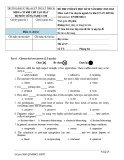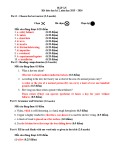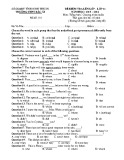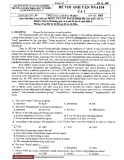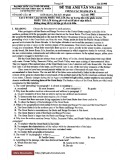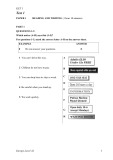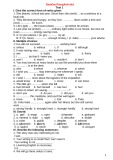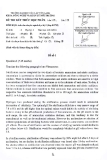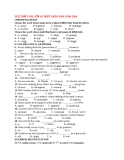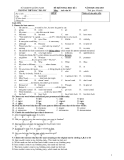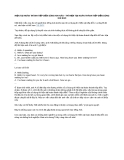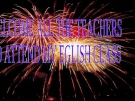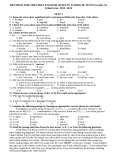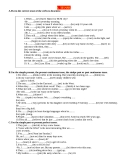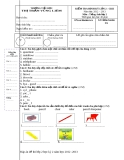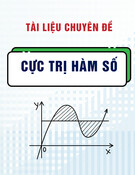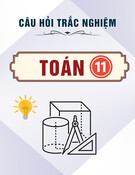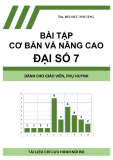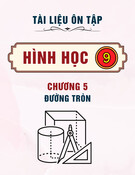Tµi liÖu luyÖn thi §¹i häc 1
Name: ________________________ PASSAGE 1:
B. can kill aquatic life when they are thrown
D. are by-products of hydroelectric plants
C. neither poor nor rich B. well-off very D.
B. He became a printer and a publisher. D. He established a library for the city.
B. His work with lightning rod. D. His scientific work with electricity.
There are two kinds of water pollution. The first is when rubbish, sewage or chemicals are thrown into the water. This waste upsets the natural environment and can prove dangerous or fatal to fish and other life in the water. The second type of pollution is thermal, or warm water pollution. This is most commonly caused by hydroelectric power plants. These take water from a lake or river, convert it into steam for running the plant's turbines, change the steam back into water, then return the water to the original lake or river. Though this water is no dirtier than when it was taken out, it is often five to ten degrees above its original temperature. This causes a change in the environment which can be as dangerous to, aquatic life as waste 'pollution. 1) It is stated In the passage that ___________ A. thermal pollution is more dangerous than pollution from rubbish or chemicals B. warm water pollution Is as harmful as thermal pollution C. hydroelectric plants put dirty water back into the environment D. thermal pollution occurs when the temperature of a river or lake is raised 2) Rubbish, sewage or chemicals ___________ A. are all part of the natural environment into the water C. are the main cause of warm water pollution 3) The author argues that ___________ A. there is nothing that can be done to correct thermal pollution B. water pollution is a fact of life that we must learn to live with C. tile world would be better off without hydroelectric power stations D. both kinds of pollution are equally bad for the natural environment PASSAGE 2: In 1723 there arrived in Philadelphia a penniless young man, eager for work and for knowledge. As the years passed, this man, Benjamin Franklin contributed greatly to his city and to his country. He became a printer and a publisher and a learned man in many subjects. He also helped to spread learning by establishing a public library and by founding the American Philosophical Society, which is an important academy of great scholars to this day. Franklin initiated many improvements in the city of Philadelphia, making it one of the world's first cities to have paved and lighted streets as well as a police force and a fire-fighting company. He also made many practical inventions such as the Franklin stove, which was a very efficient heater, and the lightening rod to protect buildings in electric storms. His scientific work with electricity earned Franklin world fame. Franklin played an important role in the early history of the United States. He took part in drawing up the Declaration of Independence and the Constitution. He was the first Ambassador to France, and he helped negotiate the treaty of 1783, which ended the Revolutionary War. As an active member and as President of the Abolitionist Society, Franklin devoted the last years of his life to the movement to end slavery. 1) When Franklin arrived in Philadelphia in 1723, he was: A. rich poor 2) How did Franklin help to spread learning? A. He was eager for work and knowledge. C. He contributed money to his city and his country. 3) What made Franklin famous all over the world? A. His work with a kind of stove. C. His work with fire-fighting company. 4) Which of the following statements is true? A. Franklin alone drew up the Declaration of Independence. B. Franklin was one of the people who drew up the Declaration of Independence. C. Franklin was never an Ambassador. D. Franklin didn't help negotiate the treaty of 1783. 5) In what was Franklin active during the last years of his life? A. The movement for liberation of slaves. B. His scientific work with electricity.
Nguyễn Đức Hưng** - Marie Curie High School, HP. (: 0912.883.190)
2
Tµi liÖu luyÖn thi §¹i häc D. The war against slaves.
B. to see the falls from a great distance D. to come to Niagara Falls for a winter
C. A walkway D. A park B. A boat
B. To show off the natural beauty of
D. To force Canada to open Queen Victoria
C. His practical inventions with electricity. PASSAGE 3: Niagara Falls, one of the most famous North American natural wonders, has long been a popular tourist destination. Tourists today flock to see the two falls that actually comprise Niagara Falls: the 53-meter high Horseshoe Falls on the Canadian side of the Niagara River and the 55-meter high American Falls on the U.S. side of the river. Most visitors come between April and October, and it is quite a popular activity to take a steamer out on to the river and right up to the base of the falls for a close-up view. It is also possible to get a spectacular view of the falls from the strategic locations along the Niagara River such as Prospect Point or Table Rock, or from one of the four observation towers which have heights up to 500 feet. Tourists have been visiting Niagara Falls in large numbers since the 1800's. Because of concern that the large number of tourists would destroy the natural beauty of this scenic wonder, the State of New York in 1885 created Niagara Falls Park in order to protect the land surrounding American Falls. A year later Canada created Queen Victoria Park on the Canadian side of the Niagara, around Horseshoe Falls. 1) According to the passage, which best describes Niagara Falls? A. Niagara Falls consists of two rivers, one Canadian and the other American. B. American Falls is considerably higher than Horseshoe Falls. C. The Niagara River has two falls, one in Canada and one in the U.S. D. Although the Niagara river flows through the U.S. and Canada, the falls are only in the U.S. 2) The passage implies that tourists prefer A. to visit Niagara Falls during warmer weather C. to take a ride over the falls vacation 3) What is a "steamer" (line 4)? A. A bus 4) According to the passage, why was Niagara Park created? A. To encourage tourists to visit Niagara Falls Niagara Falls C. To protect the area around Niagara Falls Park 5) What is the major point the author is making in this passage? A. Niagara Falls can be viewed from either the American side or the Canadian side. B. A trip to the U.S. isn't complete without a visit to Niagara Falls. C. Niagara Falls has had an interesting history. D. It has been necessary to protect Niagara Falls from the many tourists who go there. PASSAGE 4:
B. Improvements in the Telephone and
D. A Surprise Invention
B. was Edison's principal project D. took many years
D. B. 1877 C. 1878
The invention of the phonograph happened quite by accident. Thomas Edison moved to Menlo Park, New Jersey, in 1876, where he established an industrial research laboratory. There Edison worked on a carbon telephone transmitter to improve the existing Bell system. In that laboratory a year later Edison invented the phonograph while trying to improve a telegraph repeater. He attached a telephone diaphragm to the needle in the telegraph repeater to produce a recording that could be played back. After some improvements to the machine, he recited "Mary Had a Little Lamb" and played the recognizable reproduction of his voice back to an astonished audience. 1) What is the best title for the passage? A. Thomas Edison's Many Inventions Telegraph C. The History of Menlo Park 2) According to the passage, the invention of the phonograph A. was quite unplanned C. was surprising to no oneonists 3) In what year did the invention of the phonograph occur? A. 1876 The article does not say. 4) According to the passage, how was the phonograph made?
Nguyễn Đức Hưng** - Marie Curie High School, HP. (: 0912.883.190)
3
Tµi liÖu luyÖn thi §¹i häc B. From a recording of a telegraph D. From a combination of telephone and
B. He used a carbon transmitter.
C. Aggravated D. Detached B. Amazed A. With a telephone needle and a recorder C. With only a telegraph repeater telegraph parts 5) According to the passage, how did Edison test his new invention? A. He made improvements to the machine. C. He read a children's rhyme. D. He reproduced the audience's voice. 6) According to the passage, how did people feel when they heard Edison's rendition of "Mary Had a Little Lamb"? A. Perplexed PASSAGE 5:
B. live near people C. need beekeepers D. work
B. Convert it into honey. D. Use it to build their hives.
B. golden-colored packs C. honey sacks D.
B. amount of sugar the beekeepers give
D. season in which the nectar is
The bee, like the ant, is a social insect. Bees live in groups in a hive, and every bee does certain work that helps the other members of the group. In a beehive there are three kinds of bees: the queen bee, the drones, and the workers. The worker bees go from flower to flower collecting nectar, or juice, which is composed mostly of sugar mixed with water. Bees draw this nectar into the honey sacks of their bodies, and enzymes in their bodies turn the nectar in to honey, This newly made honey oozes from the underside of the bees and is stored in cells in the hive to be used as food during the winter months. Some people are in the honey business and keep hundreds of hives. Beekeepers remove honey from the hives and pack it in bottles or jars. Honey usually appears as a clear golden-colored liquid, but this depends on the kind of flower from which the bees have taken the nectar. 1) Bees are called social insects because they A. live in groups hard 2) What do bees do with nectar ? A. Change it into sugar. C. Give it to the queen bee. 3) Honey is usually sold in A. beehives bottles or jars 4) The color of honey in its final stage depends on the A. type of flower from which the nectar was taken the bees C. quantity of water available to the bees collected PASSAGE 6 D B D
5.D 5.C 6.B 2.A 2.A 2.B 3.B 3.B 3.A 4.C 4.D 4.A 1 2 3 EX 4: 1.C EX 5: 1.D EX 6: 1.A
Nguyễn Đức Hưng** - Marie Curie High School, HP. (: 0912.883.190)


